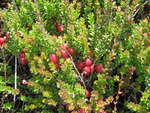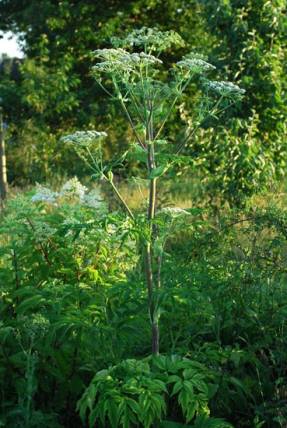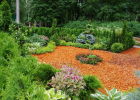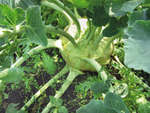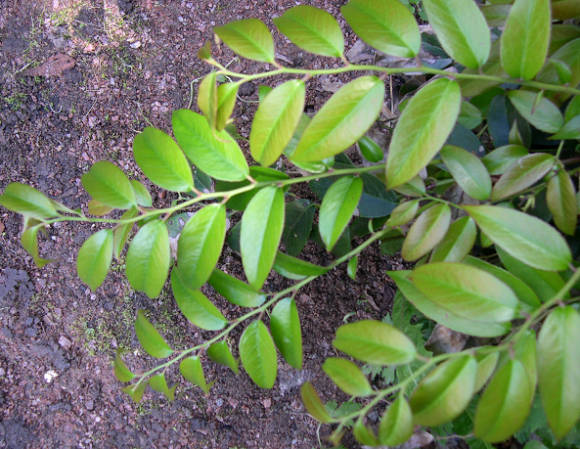
Lipa no longer plays the role in our life that it had in the recent past. Washcloths and bags are now plastic, shoes are made of artificial leather, spoons and ladles are made of stainless steel.
Soft, fine-grained linden wood is easy to cut and polish. Where linden grew in abundance, it found widespread use in the household. Simple peasant furniture was made of linden, simple dishes and barrels for bulk products were sharpened, children's toys were made, boxes, chests, boxes were made. Now all this is done from other materials.
If in some way the tree has not lost its position, it is in the manufacture of various chiseled souvenirs - nesting dolls, wooden sculptures, painted dishes, etc. And what can never be taken away from a linden is its melliferous qualities. Where there is a linden tree - God himself ordered to put an apiary.
"Not every bast in the line ..."
Bast is a separate strip of the inner layer of the bark (bast) of a tree. Bast can be obtained from elm, willow, oak. But lime bast is considered the best in quality. Bast was harvested (felled) from young trees, the trunk diameter of which did not exceed 15 cm. In order for the bast to separate from the outer layer of the bark, it was first soaked. After soaking, the bast was torn off and dissolved into separate strips - "lychins".

Linden bast was used for a variety of household needs. Matting and bast shoes were woven from the coarsest bast. The bast obtained from the youngest trees, if it is additionally milled into fine threads, is suitable for weaving ropes and even coarse, like sackcloth, woven fabric - sackcloth.
Once we hired a temporary worker in our nursery. He stood on the stock exchange, received a small allowance, and the additional income was very useful to him. Our work is simple and not physically difficult. Payment - hourly, calculated at the end of the day - worked seven hours - get seven hundred rubles. He worked for the day, we liked it - he is not lazy, does not cheat. And he, apparently, also liked the job. Real money, and immediately - what's wrong ?!
The next day he appeared again. We say hello to the hand - and he reeks of fumes. So I celebrated yesterday. Well, okay, I think, with whom it does not happen, he looks quite cheerful. Is it worth worrying - work for an hour - sober up. It actually worked fine at first. But then he went to the toilet and came from there "another" - not just completely drunk, but no longer sober. Apparently he had a "fanfurik" in his pocket, from which he sipped. The first change in him was noticed by his wife: “Look, he bast does not knit! Soon it will come to the point - what kind of worker he is! " And indeed, it began to be delivered literally before our eyes. At first it was a little "skidding when cornering." His movements have lost their precision. First, he stepped on a plastic seedling crate and crushed it. Then he completely stumbled and fell into the greenhouse with his hands, damaging several plants. In general, such work threatened to bring ruin instead of benefit.
My head is arranged "in a wonderful way." Something in her caught on to the phrase "Bast does not knit" and by itself it began to unwind: - Lyka does not knit - it means he is so drunk that his legs do not walk and his tongue is braided. So much so that he cannot perform the simplest work - tying the bast strips with a simple knot into bundles. At home, he began to find out the origins of Russian proverbs and phraseological units, in which linden is mentioned in one way or another. It turned out that there are a dozen of them.
In the "technological chain" of bast processing, the simplest operation was considered to be the bast bundling into bundles. It was assigned to the most inexperienced and inept workers. Therefore, the inability to "knit a bast" began to mean extreme sluggishness. And such a Russian peasant could only be in a strong drink.
Not sewn with a bast, not belted with a bast... The poor strata of the population in Russia did not have the opportunity to acquire real fabrics, and often used various homespun surrogates. Based on this, both of these proverbs meant - say, "we are not one of the poorest and most backward." In verbal use, mirror images of these sayings were also used - "bast shit" and "belted bast", that is, extremely poor, from a backward, impoverished hinterland.
Not every bast to string... Most often, matting and bast shoes were woven from bast. Horns had a wide variety of economic uses. Horn bags, for example, were used not only for potatoes, but also for many bulk materials and products. Therefore, the need for matting was very high. Artels were engaged in weaving matting. Of course, this work required, if not skill, then a certain skill - the cross stitches must be quickly threaded into the appropriate places. And the shuttle did not always get to the right place - to the right "line". This, however, was not considered a great sin. The proverb, in essence, means that one should not condemn someone because of any one mistake - "not every bast in the line" - "and there is a blunder on the old woman."
Linden, linden print, linden documents. The thin-layered linden wood allows you to cut out very delicate crafts from it, up to printed cliches. This was often used by crooks. Linden seal means fake.
Linden wood is fragile, so you cannot make any critical parts for inventory from it. Therefore, the words "fake" and "unreliable" were perceived by the people as synonyms.
The mat is great, but it is useless to wear it. Usually they talked about something affordable, but of poor quality, for which there is no use. From matting, you can make not only bast shoes, but even weave a rough garment. But such "clothes" in the eyes of others looked extremely unpresentable and not prestigious.
1959 sponge
It was the spring of 1959. My father had just retired from the army and was building a house in Vladimir. My sisters and I were assigned to my grandfather in the village during the construction. We lived in his small hut, built according to the classic Russian layout: in the very center there is a stove-stove, and everything else is around it. On this stove, we whiled away the long winter evenings, playing simple card games: "The Drunkard" and "The Throwing Fool". This year, on the one hand, flashed by unnoticed, but on the other, it was so filled with impressions that all the years that have passed since that time feeds me with bright memories.
My grandfather is 73, I will soon be 7 - the last summer at large. But we lived in perfect harmony with him, and did not spill water. We go to the bath together. He works in the garden - and I'm spinning around. He goes to the forest - and I am with him. I feel good with him, my grandfather for me is just like Arina Rodionovna, only masculine. Constantly tells something interesting. All the sayings and jokes. Let's go to the forest - he teaches me how to navigate in the forest. Just go away from the village, he asks - Well, which way is the house? I'll strain my brains and show with my hand:
- There.
- Eh, no - there!
I am surprised - Well, how is it there! After all, they did not turn off anywhere, so the house should be in the back.
- It seems that it seems, but only the path, albeit imperceptibly, turned.
- Grandpa, how do you know where the house is?
- Well, first of all, every bush is familiar to me here. And secondly, I am guided by the sun. When we entered the forest, it was in front, which means we have to go back in such a way that it shines in the opposite direction from behind. Given that it moves, of course.
We both loved to go to the forest most of all. Actually, there was no need to go anywhere, it started right behind the picket fence. Mixed Russian forest for many kilometers in all directions. I opened the gate at the back - and you are in the forest. Chanterelles grew five meters from the fence. And white people sometimes grew up in the garden itself!
The grandfather was a real woodman. He knew and understood the forest. He loved the forest, he felt it. The forest gave him, if not everything, then a lot, including psychotherapy: he fed him, supplied him with firewood and building materials. Grandfather never went to the forest just like that. Always out of necessity.And he never returned from the forest empty-handed, so he would take something. Either an aspen pole for the stockade, or hazel sticks for peas. Although a rotten deck, it will. Rotten, I will explain, he needed to fumigate bees.
My grandfather did not teach me - he did not put me at the desk, did not put me in a corner for disobedience, did not read the lectures. In general, he did not force me to do anything. He only did his household chores - he melted the stove, cooked cabbage soup, planed, sawed, looked after the bees ... And I was with him and saw all this. Sometimes I wanted to do something myself - my grandfather did not interfere with this, but only gave advice. Since his advice was always on the case, I somehow immediately got used to take them seriously.
“You’re not holding the ax like that!” And spread your legs, otherwise you will bite yourself on the shins. So you can lose your legs!
- I'll give you the bowstring. But spruce is not good for onions. You need hazel or willow.
- But for a staff, a spruce will do, you just need to peel off the bark from it. But it's better to make it from juniper.
So unobtrusively he instilled in me the most important thing - the desire for amateur creativity and curiosity. And as a by-product, he instilled in my soul an attachment to the forest - to its inhabitants, its sounds, its smells.
Most often we went mushrooming with him. Mushrooms were an indispensable component of our cuisine. But, like most of the Saryevsk (Saryevo station) aborigines, the grandfather did not take anything. Five of his favorite mushrooms looked like this. In the first place - salted milk mushrooms, which he prepared a whole tub. Under the load was meant only a real white milk load, others were not taken there. And black was generally considered inedible. Milk mushrooms were served on the table almost every day - sometimes with fried potatoes, or even “just like that” - with onions and vegetable oil - with black bread. Naturally, the white mushroom was also held in high esteem. His grandfather used to dry it in a Russian stove, and then all winter we ate from time to time an excellent taste of mushroom soup. I liked to eat dried porcini mushroom on its own - my grandfather did not encourage this, but he did not interfere. “On the fry,” my grandfather preferred to pick a limited number of mushrooms. For example, he practically did not take boletus. Unless it is not a mushroom year at all. And those are the strongest ones - "brisket". Perhaps his favorite "fried" were chanterelles, and certainly with sour cream. In addition, he loved fried mushrooms. And he never passed by young boletuses. And in the spring he never missed an opportunity to pick morels.
On that memorable May day, we just went for morels, the spout of which was reported to my grandfather by our neighbor Klipov. On the way back, we deviated from the usual path and entered a dense lime-tree, where the grandfather, operating with a garden knife, tore off a piece of bark from a young linden - a tube a meter long. Then, when we passed a ditch filled with melt water, my grandfather drowned linden bark in it with the help of a stone. Two weeks later, we went there again. And my grandfather, right in front of my eyes, easily separated the bast from the bark and, with the help of simple manipulations, turned it into a real washcloth. With this washcloth, then all summer we went with him to the station bathhouse and rubbed each other's backs. Now I have a plastic washcloth at home. In general, there are no complaints about her. And yet, plastic is an inanimate material, I think sometimes. And it seems that natural linden bast is more useful for human skin. Perhaps some useful substances "diffuse" from it into the skin, because linden, after all, also has medicinal properties.
So you know

According to the current botanical views, linden (Tilia) belongs to the Malvaceae family, but more recently it was isolated into a separate linden family. This emphasized the importance of this tree in the daily life of Europeans.
About 30 species of linden grow on Earth - all in the northern hemisphere, and mainly in Eurasia. The most common is the small-leaved linden, it is heart-shaped (Tilia cordata). This tree could rightfully be called Russian, since its area is almost entirely within Russia.Small-leaved linden is the most frost-resistant of lindens, it is able to endure almost 50-degree frosts without damage.
Now the existence of the linden is not threatened. Meanwhile, scientists have reliably established that linden forests once occupied a much larger area. Fossilized remains of linden are found in abundance, for example, throughout North Asia up to Chukotka and part of the Arctic islands. Paleontologists have proven that linden appeared on Earth tens of millions of years ago, at the close of the dinosaur era. Consequently, the linden tree has successfully survived many natural disasters, including several global cold snaps and glaciers.
Honey tree
No matter how expert the beekeeper may be, if the area is not rich in melliferous plants, there is nothing to dream of a good honey harvest. And there is no better honey plant in all of Russia than linden. Where this tree grows in abundance, beekeepers do not know grief. It is the linden forests, and even their hilly relief, that Bashkir honey owes its all-Russian glory. Why relief? - ask. - Because the linden forests of Bashkiria are often located on the mountainous landscape of the Ural foothills. And if on the plains the flowering of linden lasts about two weeks, then in “mountainous” conditions it is much longer - since on the southern slopes the tree blooms a little earlier than usual, and on the northern slopes, on the contrary, later. The honey productivity of small-leaved linden under favorable conditions can reach 1000 kg per hectare. And linden honey itself is considered one of the most healing.
Linden and bee seem to be specially made for each other. The flowers of the tree produce abundant nectar and provide the bees with material to rebuild their combs. And the aroma of linden flowers itself is most accurately described by the epithet - honey. It should be said that the linden blooms most abundantly when it is sufficiently free to stand. And in solid stands, flowers of trees are tied only on top. Therefore, if you want to plant a linden tree in your apiary, then place the trees no closer than 7-8 m from each other.
The linden flower is the wisest creation of nature, created by the bee for itself, but for the mutual benefit of both the tree and the insect. Let me explain what caused this statement. You all remember that a linden inflorescence consists of several (4-13 pieces) of a ray structure of flowers, and a narrow stipule leaf characteristic of a linden. So, I undertake to assert that this very leaf did not grow by itself, but with the direct participation of the bee.

Initially, the stipule had a slightly different size and was not so convenient from the point of view of the bee. But when the bees began to use it as a kind of landing board, the leaf began to gradually change towards more convenience for the bee. How did it happen? And very simply, the bee not only collects nectar from the flower, but pollinates it along the way. And the more convenient it is for her, the more successful is pollination, and hence the setting of fruits. Thus, the bee, without knowing it, carried out the selection of linden in the direction necessary for it.
The stipule has one more function - it is a kind of screw, with the help of which the infructescence, like mini-helicopters, glides to the ground. Usually, a massive separation of fruits from the tree occurs at the end of winter. They fall on the snow, and the wind drives them along the crust far, far from the mother tree. So, thanks to this "sail", the linden settles.
Grown sticky big-big

Although linden wood is fragile, the tree itself is quite durable. Not an oak, of course, but after an oak in one of the first places. In any case, 100 years is not old age for a linden tree. Dendrologists claim that linden can live for 300 years. And if you are lucky, then all 500. And this, you see, is a very serious age. The most durable of the lindens is the large-leaved linden growing in the center of Europe. (Tilia platyphyllos). Its age can reach 1000 years! She, by the way, is the largest of the lindens.
Linden is both sun-loving and shade-tolerant. At a young age, she tolerates heavy shading.But a truly powerful and spreading tree grows only in open places. In the Vladimir region, linden rarely forms homogeneous massifs. Most often, it grows with maple, oak, spruce. Linden does not like dryness, therefore it prefers moderately moist loams, it does not settle on sandy soils. In floodplain forests, the tree suffers short-term spring flooding.
Landing site.The soil. Ideally, the soil should be medium loamy, rich in organic matter. If the bedrock is composed of sand, it is advisable to dig a hole under a tree about a meter deep and in diameter. The soil substrate is prepared on the basis of medium-loamy soil: loam and humus 2: 1. Planting a linden tree with open roots is best done after leaf fall - from mid-October to the whole of November. If autumn is rainy, you can do it in September. Linden tolerates transplanting well, but when digging out a seedling, it is important not to cause severe damage to the root system.
Care. Fertilizer. Watering. If the soil and planting site are chosen correctly, linden will grow well without any maintenance. But at first, it is still advisable to help the tree. Linden does not like strong soil compaction, therefore, the tree trunk circle is shown to be kept in a weed-free, loose state. When planting, to delay precipitation, it makes sense to form a funnel-shaped depression around the trunk. It is useful to mulch the tree trunk circle from time to time with various organic materials: manure and leaf humus, peat composts, etc. The layer of mulch is 5-7 cm, it is better to replenish it in the fall, and in the spring to gradually embed it in the lower horizons of the soil. In the absence of rain for a long time, watering is recommended once a week. If possible, water it a little, but more often.
Formation. A haircut. Linden is one of the most pliable tree species to cut. If at a young age the linden tree is cut at a low height - "planted on a stump", then later it grows not as a tree in one trunk, but multi-stemmed, turning, as it were, into a tall, spreading shrub. A tree planted on a tree stump can be shaped into various simple geometric bodies - hemispheres, cubes, parallelepipeds, etc. And if linden seedlings are planted quite often - 60-100 (up to 150) cm from each other, and when the trees reach a height of 1.5-2 m, plant them on a stump, then high (3 m and higher) walls can be formed from them. These walls divide the space into separate isolated sections - bosquets, which radically transform the landscape. This is one of the most ceremonial park receptions. Linden bosquets are used to decorate the territories of many world-famous parks in France and Russia (for example, Peterhof). However, in order for linden walls to look perfect, they must be cut often (at least 5 times per season).
In urban landscaping, linden crowns are traditionally formed on a single trunk - a trunk. To do this, the lateral shoots are cut out to a height of 2-4 m, and the crown is cut and cut into a ball with a diameter of 3-5 m.

Reproduction. Linden can be propagated both by seed and vegetatively. It is easiest to propagate a tree with shoots, which it often gives in abundance. It is not difficult to propagate by cuttings - both winter (that is, lignified) and summer (green). In the forest, you can often observe how linden shoots pressed to the ground give roots - and this is nothing more than spontaneous layering.
Linden can be propagated by sowing seeds. They are harvested from late autumn to spring and stored in the snow. The specificity of seed reproduction is that even with such natural stratification, the seeds germinate in another year. It is advisable to place the sowing bed in a light mesh penumbra on a light loamy soil rich in humus. Sowing is done as follows: nuts are sparsely scattered over the soil surface, and sprinkled a little so that they are not covered at all, but only fixed from moving by the wind. In its first summer, a linden seedling grows only 5-7 cm.If it is not transplanted, then by the age of 6 its height reaches one meter and a 2-centimeter diameter in the butt.The first flowering, even if the tree is lucky with the soil and location, should be expected when it reaches a height of 4-5 m, and no earlier than 15 years.
Plants for the garden by mail
Shipping experience in Russia since 1995.
Catalog in your envelope, by e-mail or on the website.
600028, Vladimir, 24 passage, 12
Smirnov Alexander Dmitrievich
E-mail: [email protected]
Tel. 8 (909) 273-78-63
Online store on the sitewww.vladgarden.ru

